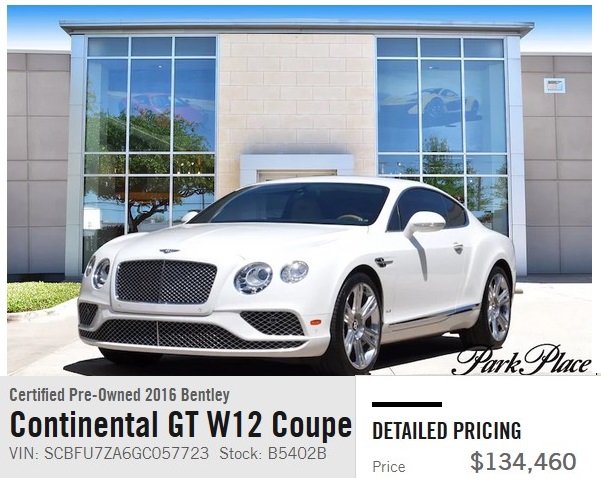Here’s an example of “studies” that just set my hair on fire:
The LEAST reliable used cars revealed
Warrantywise has published data from its Reliability Index for older cars
A minimum of 100 examples of each car is needed to provide a reliability score
…but here’s where the turd hits the punchbowl:
It measures reliability based on the volume and cost of repairs to vehicles
Including cost of repairs means that.. wait for it… cars like Bentley and Audi are going to fall to the bottom of the list, regardless.
Here’s the scenario:
- one of their “reliable” cars (e.g. the Dacia Sendero, a complete POS) may have ten problems after its warranty expires, but because the average cost of repair is $100 (Dacias being made of plastic and scrap metal), its score comes to 1000
- an Audi A7 breaks down only twice, but its average cost of repair is $1,500 (because when quality stuff does break, it’s expensive to fix), giving it a score of 3000 — so the Audi is three times less “reliable” than the Dacia, according to the study.
But in terms of actual (instead of cost-weighted) reliability, your Dacia was in the shop ten times, compared to the Audi’s twice.
I’m not saying that’s what happened in the study (I don’t have access to the raw data), but that’s the problem when you add irrelevant factors to an equation.
The real problem lies with the title. If Warrantywise had called their study “Total Cost Of Post-Warranty Ownership”, it would have given the output a better foundation.
Or if they were going to stick with reliability, they should have ignored cost and instead stressed weighting factors of “frequency of breakdown” and “magnitude of failure” (brake lights fail, no big deal; transmission dies, much more serious). That, at least, would have given prospective buyers a clue.
All that said, I’d still get one of these (with only 12,000 miles usage)

…over a poxy Mitsubishi anything.

(See what I did there? About the same thing as Warrantywise did. It’s called “bias”.)
Anyway: if you can afford to buy it, you should be able to afford to maintain it.
And can ignore silly studies.

Maybe they also take into account that although your Bentley is in the shop for a broken tail light, there’s a three month delay while they make the needed bespoke LED replacement Taillight assembly – $ 2.400.00 for your car. But that’s OK, because nobody has just one Bentley.
Note that all the other “least reliable” are also low mileage, while all the “reliable” cars are high mileage. It’s not good for a vehicle to sit in the garage most of the time.
Whoever wrote this views cars as appliances, and lives in the city and doesn’t own a car.
“It’s not good for a vehicle to sit in the garage most of the time.”
Over the years I’ve bought multiple vehicles that were older (20+ years) and “low mileage”. Ads with words like “it was running fine when I parked it”, or “Grandpa loved this truck, he really took care of it. It’s been 5 years and we still miss him”. Even when they claim they’ve been using it as a daily driver with no issues, a quick check confirms it has been sitting for a long time.
And you’re right. The bones may still be good, but there’s lots of little things that just up and break after sitting idle for so long. I got pretty good at knowing exactly what to replace immediately when trying to get a vehicle back to road-worthy condition. Thankfully I’m not in that financial position anymore, although with this Covid nonsense I probably need to get my stable of motorcycles out and start driving them again. 3+ months of work-from-home and my vehicles have seen almost no road time.
The Bentley is nice.
But I got to sit in a Maserati Quattroporte in the Texas Direct Auto showroom a couple of yrs ago, in Stafford, TX. I think it beats the Bentley.
I REALLY liked it, and Mrs Termite was in love with the car. They wouldn’t let us take it for a test drive, though……….LOL……
https://www.maseratiusa.com/us/en/models/quattroporte
The reason it’s so difficult to quantify things like “reliability” is that there are too many areas that are open to subjective interpretation.
I have noticed, though, that “luxury” marques that are just OOW (Out Of Warranty) can often be purchased at surprisingly low prices – which is why I personally avoid them like the plague.
There’s a reason an out-of-warranty BMW or Audi is often comparably priced with an out-of-warranty Toyota or Ford (even though the BMW or Audi was thousands more when new.) Because the only thing worse than having a vehicle break down is having a vehicle break down and then being handed a bill for 25% of what you paid, just to get it back on the road.
I’m reminded of the old Jerry Seinfeld routine where he talked about the trend of “technicians” at high-end auto dealerships trading their greasy overalls for white lab coats: Something like “if the auto mechanic is wearing a lab coat, you KNOW you’re gonna get screwed.”
Every few years the wife wants a new(er) car and the last time we went shopping she had her eye on a 4 or 5 year old Mercedes SUV. She loved the luxurious interior. So I started doing research and told her I’d be happy to get her the car as long as she paid for the maintenance on it.
I then ran a printout of what maintenance was required and the approximate cost.
She bought a Honda instead.
In 1989 my Product Line Manager drove a Cadillac. He said once that there seemed to be a rule that the hood could not be raised without a minimum $100 charge.
Thirty one years later, inflation has hit my own car. Whatever the All Electronic Plastic Fantastic may have wrong with it, from sensor to A-Arm, it’s minimum $100.
Regardless of this survey, I tell people all the time: “Reliability has value.”
Behind the wheel, most of us have essentially two roles.
One role is as a driving enthusiast. For that you want something sweet, like that Bentley. Most of us mere mortals cannot afford even a portion of a car like that, much less the maintenance on it.
The other role, and it’s probably more than ninety per cent of our driving, is as a transportation consumer. This is driving we’d really rather not do – commuting, fetching the kids from piano lessons, or picking up groceries.
Under those circumstances, the reliability of the car becomes extremely important. And reliability includes two components. How often does it break down. And, when it does – because it is a machine, and ALL machines eventually will fail – how much does it cost to get it back on the road.
For most of us – mere mortals again – the driving experience goes as well as it possibly can when the car starts and gets us to work on time without fuss. We didn’t have to call AAA, or coax it in for repairs, or bum a ride and get to work late, or any of that.
After that, as transportation consumers, economy is probably the second most important way we evaluate the car – good fuel economy, high resale value, *low* maintenance, repair and insurance cost.
While actually behind the wheel, in traffic, the next most important thing in the transportation consumer experience is probably the signal-to-noise ratio between the radio and ambient noise. We want the car to be fairly quiet, and well, somewhat comfortable too.
And we want to feel reasonably safe when tailgated by an Escalade.
Cars like the Toyota Camry and Corolla, the Honda Accord, the Subaru Outback, excel in what transportation consumers want. And Toyota, for example, has sold millions of Camrys and Corollas and made a crap-load of money doing it.
I’ve got to admire that. So, in my role as transportation consumer, I want a Camry, or an Accord, or even a Dodge minivan. When I can afford to dedicate a significant chunk of my income to the driving enthusiast role, I’ll add something else to my garage, just for fun, right next to the Camry. But it won’t be a Bentley, or any car like it, because even if I could afford it, I’ve got much better things to spend my money on than an overpriced status symbol automobile.
Not exactly a ‘reliability’ test, but were you aware that there is a make and model of car so hard to damage that most demolitions derbies have a rule against it?
The 1964-1966 Chrysler Imperial.
When I was a teenager in the late sixties, my best friends dad had a 66 Imperial. We called it the “battlecar”. All that was missing were the 16″ gun turrets. You didn’t drive off in that car, you got underway.
It was a solid car but mechanically, it was not the most reliable car. Among many repairs, it eventually developed a small drip leak in the gas tank and when my friend’s dad had it in to repair the gas tank, the car was lost in a fire at the repair garage.
Sounds like instead of “Death by demo derby” it was”Viking funeral”, then…
The thing about those Imperials, in addition to the full X frame is that they used thicker sheet metal than the Chryslers of the same vintage.
And Kim, nice pick for the Bentley vs Mitsubishi, but I’d rather have an Azure.
“If you have to ask ‘how much it costs’, you can’t afford it.”
– J.P.Morgan (allegedly)
“Where are the customers’ yachts?”
— Some anonymous newspaper reporter, sent west so the newspaper could continue to get “inside” information.
Anyway: if you can afford to buy it, you should be able to afford to maintain it.
Don’t even get me started on this one I use that phrase at work all to often “Cheap bastards”
Re: Mitsubishi v.s. Bentley
I’d take a late model Pajero Turbo Diesel, if I could get one.
I’ve noticed that at some point Toyota light trucks stop depreciating. Brute reliability may have something to do with it.
I believe it was Benjamin Disraeli who first said, “There are Lies, Damned Lies, and Statistics.”
I can’t give proper attribution, but, ” Torture numbers enough, and they will admit to anything.”